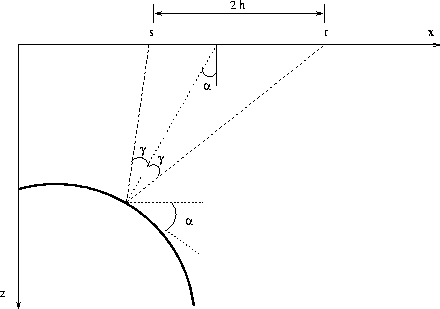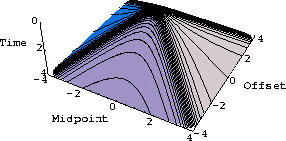|
rays
Figure 1 Reflection rays in a constant-velocity medium: a scheme. |  |
|
rays
Figure 1 Reflection rays in a constant-velocity medium: a scheme. |  |
Let us consider a simple reflection experiment in an effectively constant-velocity medium, as depicted in Figure 1. The pair of incident and reflected rays and the line between the source s and the receiver r form a triangle in space. From the trigonometry of that triangle we can derive simple relationships among all the variables of the experiment Fomel (1995, 1996a, 1997).
Introducing the dip angle ![]() and the reflection angle
and the reflection angle ![]() ,the total reflection traveltime t can be expressed from the law of
sines as
,the total reflection traveltime t can be expressed from the law of
sines as
| |
(1) |
Additionally, by following simple trigonometry, we can connect the half-offset h with the depth of the reflection point z, as follows:
| |
(2) |
Finally, the horizontal distance between the midpoint x and the
reflection point ![]() is
is
| |
(3) |
Equations (1-3) completely define the kinematics of angle-gather migration. Regrouping the terms, we can rewrite the three equations in a more symmetric form:
 |
(4) | |
| (5) | ||
| (6) |
![\begin{eqnarray}
z^2 & = &
\frac{
\left[(v\,t/2)^2 - (x-\xi)^2\right]\,
\le...
...left[(v\,t/2)^2 - (x-\xi)^2\right]}
{(v\,t/2)^4 - h^2\,(x-\xi)^2}\end{eqnarray}](img9.gif) |
(7) | |
| (8) | ||
| (9) |
The lines of constant reflection angle ![]() and variable dip angle
and variable dip angle
![]() for a given position of a reflection (diffraction) point
for a given position of a reflection (diffraction) point
![]() have the meaning of summation curves for angle-gather
Kirchhoff migration. The whole range of such curves for all possible
values of
have the meaning of summation curves for angle-gather
Kirchhoff migration. The whole range of such curves for all possible
values of ![]() covers the diffraction traveltime surface -
``Cheops' pyramid'' Claerbout (1985) in the
covers the diffraction traveltime surface -
``Cheops' pyramid'' Claerbout (1985) in the ![]() space of seismic reflection data. As pointed out by
Fowler (1997), this condition is sufficient for proving the
kinematic validity of the angle-gather approach. For comparison,
Figure 2 shows the diffraction traveltime pyramid from
a diffractor at 0.5 km depth. The pyramid is composed of
common-offset summation curves of the conventional time migration.
Figure 3 shows the same pyramid composed of
constant-
space of seismic reflection data. As pointed out by
Fowler (1997), this condition is sufficient for proving the
kinematic validity of the angle-gather approach. For comparison,
Figure 2 shows the diffraction traveltime pyramid from
a diffractor at 0.5 km depth. The pyramid is composed of
common-offset summation curves of the conventional time migration.
Figure 3 shows the same pyramid composed of
constant-![]() curves of the angle-gather migration.
curves of the angle-gather migration.
|
coffset
Figure 2 Traveltime pyramid, composed of common-offset summation curves. |  |
|
cangle
Figure 3 Traveltime pyramid, composed of common-reflection-angle summation curves. |  |
The most straightforward Kirchhoff algorithm of angle-gather migration can be formulated as follows:
| |
(10) |